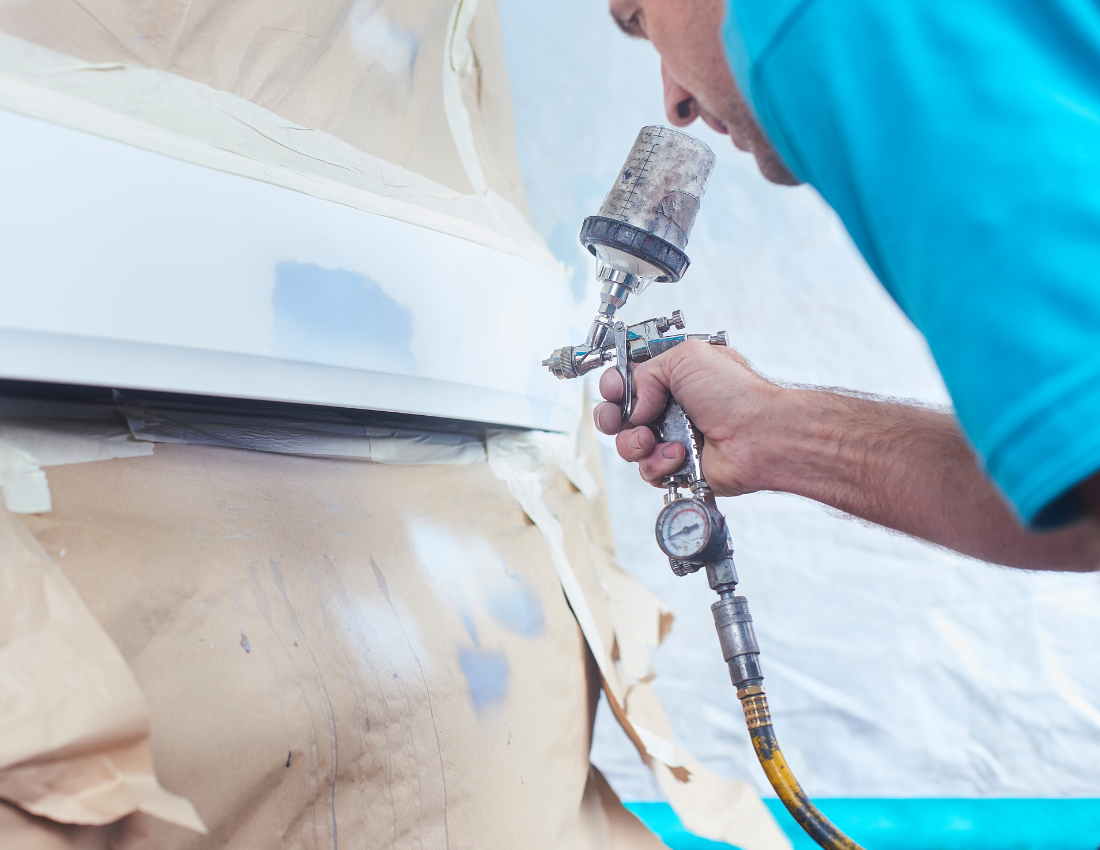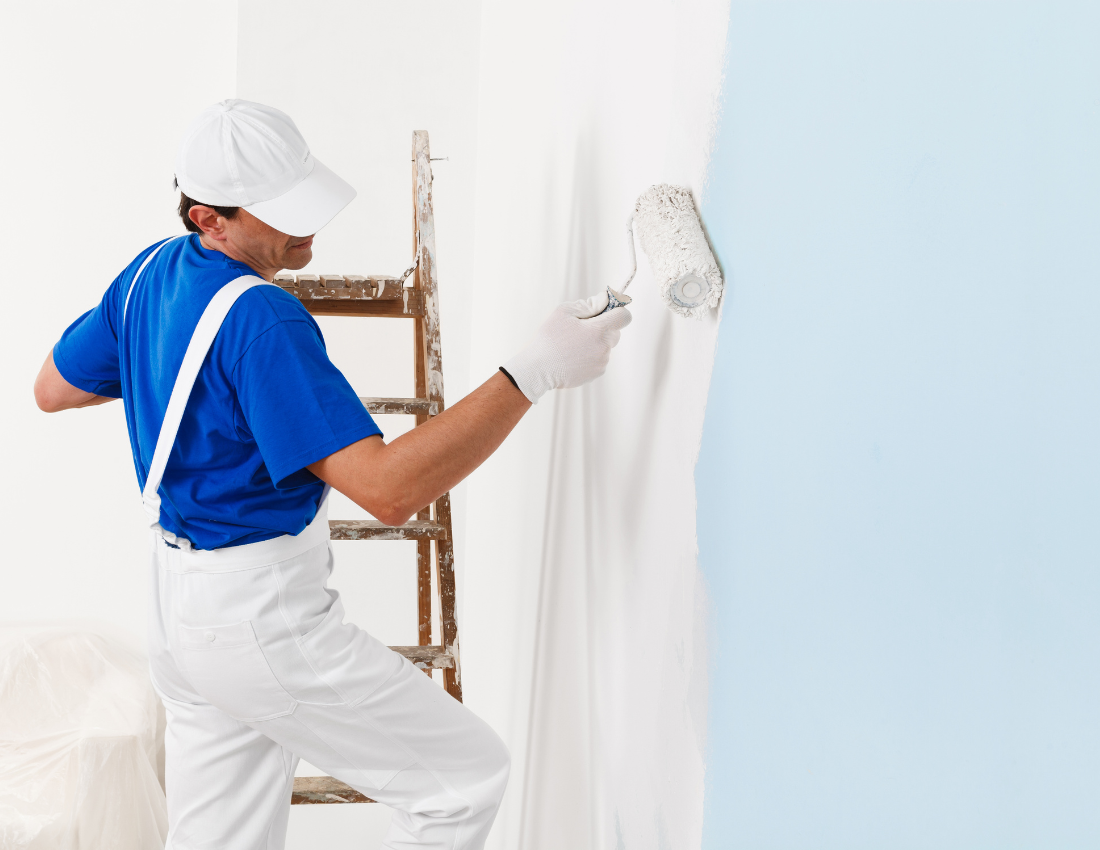Painting is one of the easiest ways to update a home, but choosing the right method can make a big difference in how your house painting project turns out. Roller painting vs spray painting is a common debate among homeowners in Dunwoody, GA.
Do you go with a roller for more control and a cleaner process, or do you use a sprayer for speed and a flawless finish?
Some homeowners prefer the steady, precise application of a roller, while others appreciate the efficiency of a sprayer—especially for large or textured surfaces. Both methods have pros and cons, and understanding the differences can help you get a professional-looking result, whether you’re painting a single room, a ceiling, or an entire exterior.
In this guide, you’ll learn about the best uses for spray painting and roller painting, along with the advantages, drawbacks, and expert tips to help you get the best results.
Key Takeaways:
- Spray painting is best for large, textured surfaces like brick, stucco, and popcorn ceilings but requires more prep work and uses more paint.
- Roller painting is ideal for indoor walls, ceilings, and smaller projects, offering better control and less mess.
- Sprayers provide a smooth, even finish but need masking to prevent overspray.
- Rollers are easier for beginners, require less prep, and are more budget-friendly.
- Choosing the right method depends on your project size, surface type, and experience level.
Spray Painting: The Best Choice for Large or Textured Surfaces

Spray painting is widely used by professional painters in Dunwoody GA, especially for larger painting projects or highly detailed surfaces where a roller may not be as effective. While a sprayer can speed up the painting process, it also requires more prep work, greater attention to ventilation, and a higher volume of paint than rolling.
Spray Painting Works Best on Textured & Detailed Surfaces
Sprayers are ideal for rough, grooved, or intricate surfaces where a roller might struggle to reach. The fine mist produced by a sprayer allows paint to evenly coat every crevice, eliminating clumping, missed spots, or uneven application.
Some of the best surfaces for spray painting include:
- Popcorn ceilings and textured drywall. Rolling over these surfaces can leave paint buildup in some areas while missing others. A sprayer provides consistent coverage without damaging the texture.
- Brick, masonry, and stucco. Porous surfaces absorb paint quickly, requiring extra coats when using a roller. A sprayer distributes paint evenly across the surface, reducing the need for additional layers.
- Deep grooves and raised paneling. Surfaces with detailed patterns, such as crown molding, decorative trim, or wainscoting, benefit from the smooth, even coverage a sprayer provides.
If you’re wondering how many coats it takes to fully cover textured surfaces, check out how many coats of paint your walls need for expert guidance.
Spray Painting Covers Large Areas Faster
One of the biggest advantages of a paint sprayer is its ability to cover large areas quickly. Instead of dipping and reloading a roller, a sprayer continuously releases paint, making it an efficient choice for:
- Exterior house painting. Sprayers allow painters to finish siding, trim, and garage doors in significantly less time than rolling.
- Basement walls and ceilings. If you’re painting unfinished spaces with exposed beams or rough drywall, a sprayer makes it easier to reach every surface.
- Fences and outdoor structures. Wooden fences, pergolas, and playsets can be coated quickly and evenly using a sprayer.
Prep Work: Masking is Required
Although spray painting speeds up application, it also requires extensive preparation. Since paint mist is released into the air, it can settle on surfaces you don’t want painted, including floors, windows, and furniture.
Proper preparation before spray painting includes:
- Masking off windows, baseboards, and floors. Any surface not being painted must be covered to prevent overspray.
- Taping off trim, outlets, and fixtures. Unlike rolling, where you have more control over where the paint goes, a sprayer distributes paint across a larger area.
- Ensuring proper ventilation. If using oil-based paints or waterproofing products, working in a well-ventilated space is essential to avoid health risks.
If you’re refinishing furniture, painting cabinets, or tackling any detailed project, a sprayer can provide a professional, factory-like finish. But be prepared for the extra prep work involved.
Roller Painting: The Practical Choice for Interior Walls & Ceilings

If you’re looking for control, precision, and a simpler painting process, roller painting is the better choice. Unlike sprayers, which can create overspray and require more masking, rollers allow for a cleaner and more controlled application.
Why Rollers Are the Preferred Choice for Interior Spaces
For most house painters in Dunwoody GA, rollers are the standard choice for painting indoor spaces. Rollers provide:
- Better control over coverage. Unlike sprayers, which disperse paint in a fine mist, rollers apply paint directly to the surface with less chance of waste.
- Minimal masking requirements. Since rollers don’t create overspray, there’s less need to cover furniture, windows, or fixtures.
- A budget-friendly option. Rollers use less paint than sprayers, making them an economical choice for homeowners.
Easier for Beginners & DIY Painters
If you’re painting for the first time, a roller is the safer choice. Sprayers require pressure adjustments, proper nozzle selection, and specific hand movements to avoid streaks, while rollers are much simpler to use.
With a roller, you can:
- Easily control how much paint is applied. You can adjust pressure and direction without worrying about mist settling in unwanted areas.
- Pause and resume painting as needed. If you need to take a break, you can cover the roller tray and pick up where you left off.
- Achieve a more even coat with fewer mistakes. Rolling paint onto a surface provides better consistency compared to spraying, where improper technique can lead to uneven application.
If you’re trying to match new paint with existing colors, check out how to match wall paint colors without repainting for helpful tips.
Best Uses for Roller Painting
Rollers work well for a variety of interior projects, including:
- Walls in bedrooms, living rooms, and kitchens. A roller is ideal for rooms where clean lines and even coverage are important.
- Ceilings. Unlike sprayers, which can create a mist of paint falling onto furniture and floors, rollers keep paint contained.
- Trim, baseboards, and molding. A small roller can easily coat these surfaces with better precision than a sprayer.
We already discussed the importance of knowing when to use roller painting vs spray painting, but it’s just as important to understand how different types of interior paint impact your project. The right paint choice can affect durability, ease of application, and the final appearance of your walls, ceilings, and trim.
For example, flat and matte finishes work well for living rooms and bedrooms because they help hide imperfections, while semi-gloss or satin finishes are better suited for kitchens and bathrooms due to their moisture resistance and easy cleaning. When painting trim or molding, a glossy finish can highlight architectural details while providing added durability.
Roller Painting vs Spray Painting Summary
Both roller painting and spray painting have advantages, but the best choice depends on your project size, surface type, budget, and skill level. If you’re painting large or highly textured areas, a sprayer may be the fastest solution, while rollers offer more control and precision for indoor walls and occupied spaces.
Below is a comparison to help you decide:
| Best For | Spray Painting | Roller Painting |
|---|---|---|
| Large Areas | ✅ Faster coverage | ❌ Requires more time |
| Textured Surfaces | ✅ Reaches grooves and crevices easily | ❌ Harder to cover evenly |
| Furniture & Cabinets | ✅ Provides a smooth, factory-like finish | ❌ May leave subtle roller texture |
| Interior Walls & Ceilings | ❌ Risk of overspray, more prep required | ✅ Offers better control and clean edges |
| Budget-Friendly Projects | ❌ Uses more paint due to mist loss | ✅ Less waste, saves money on materials |
If you’re still unsure which method to use, think about how much time you’re willing to spend on prep work, how comfortable you are with masking and taping, and whether you prioritize speed or precision.
Sharper Impressions Atlanta’s Painting Process & How We Can Help
Our house painters in Dunwoody GA provide expert interior and exterior painting services in Alpharetta, Acworth, Marietta, GA, and the surrounding areas.
- Surface Prep. Cleaning, repairing drywall, and priming for better adhesion.
- Masking & Protection. Covering floors, windows, and trim to prevent unwanted paint coverage.
- Expert Application. Using the best tools—rollers, sprayers, and brushes—for flawless results.
- Final Touch-Ups & Cleanup. Ensuring a smooth, clean finish with no mess left behind.
Call 678-922-4970 today for your FREE estimate!




